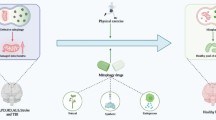Abstract
6-Hydroxydamine has widely been used as neurotoxin in preclinical studies related on the neurodegenerative process of dopaminergic neurons in Parkinson’s disease based on its ability to be neurotoxic as a consequence of free radical formation during its auto-oxidation to topaminequinone. We report that 50-µM 6-hydroxydopamine is not neurotoxic in RCSN-3 cells derived from substantia nigra incubated during 24 h contrasting with a significant sixfold increase in cell death (16 ± 2 %; P < 0.001) was observed in RCSN-3NQ7 cells expressing a siRNA against DT-diaphorase that silence the enzyme expression. To observe a significant cell death in RCSN-3 cells induced by 6-hydroxydopamine (24 ± 1 %; P < 0.01), we have to increase the concentration to 250 μm while a 45 ± 2 % cell death (P < 0.001) was observed at this concentration in RCSN-3NQ7 cells. The cell death induced by 6-hydroxydopamine in RCSN-3NQ7 cells was accompanied with a (i) significant increase in oxygen consumption (P < 0.01), (ii) depletion of reduced glutathione and (iii) a significant decrease in ATP level (P < 0.05) in comparison with RCSN-3 cells. In conclusion, our results suggest that one-electron reduction of 6-hydroxydopamine quinone seems to be the main reaction responsible for 6-hydroxydopamine neurotoxic effects in dopaminergic neurons and DT-diaphorase seems to play an important neuroprotective role by preventing one-electron reduction of topaminequinone.





Similar content being viewed by others
References
Arriagada A, Paris I, Sanchez de las Matas MJ, Cardenas S, Castañeda P, Graumann R, Perez-Pastene C, Olea-Azar C, Couve E, Herrero MT, Caviedes P, Segura-Aguilar J (2004) On the neurotoxicity of leukoaminochrome o-semiquinone radical derived of dopamine oxidation: mitochondria damage, necrosis and hydroxyl radical formation. Neurobiol Dis 16:468–477
Fernandez-Gomez FJ, Pastor MD, Garcia-Martinez EM, Melero-Fernandez de Mera R, Gou-Fabregas M, Gomez-Lazaro M, Calvo S, Soler RM, Galindo MF, Jordán J (2006) Pyruvate protects cerebellar granular cells from 6-hydroxydopamine-induced cytotoxicity by activating the Akt signaling pathway and increasing glutathione peroxidase expression. Neurobiol Dis 24(2):296–307
Fuentes P, Paris I, Nassif M, Caviedes P, Segura-Aguilar J (2007) Inhibition of VMAT-2 and DT-Diaphorase induce cell death in a substantia nigra-derived cell line-an experimental cell model for dopamine toxicity studies. Chem Res Toxicol 20:776–783
Gee P, Davison AJ (1984) 6-hydroxydopamine does not reduce molecular oxygen directly, but requires a coreductant. Arch Biochem Biophys 231:164–168
Glinka Y, Gassen M, Youdim MB (1997) Mechanism of 6-hydroxydopamine neurotoxicity. J Neural Transm Suppl 50:55–66
Gregorio ML, Wietzikoski EC, Ferro MM, Silveira JL, Vital MA, Da Cunha C (2009) Nicotine induces sensitization of turning behavior in 6-hydroxydopamine lesioned rats. Neurotox Res 15:359–366
Hara H, Ohta M, Ohta K, Kuno S, Adachi T (2003) Increase of antioxidative potential by tert-butylhydroquinone protects against cell death associated with 6-hydroxydopamine-induced oxidative stress in neuroblastoma SH-SY5Y cells. Brain Res Mol Brain Res 119:125–131
Hardie DG (2000) Metabolic control: a new solution to an old problem. Curr Biol 10:757–759
Heikkila R, Cohen G (1971) Inhibition of biogenic amine uptake by hydrogen peroxide: a mechanism for toxic effects of 6-hydroxydopamine. Science 172:1257–1258
Heikkila RE, Cohen G (1973) 6-Hydroxydopamine: evidence for superoxide radical as an oxidative intermediate. Science 181:456–457
Jia Z, Zhu H, Misra HP, Li Y (2008) Potent induction of total cellular GSH and NQO1 as well as mitochondrial GSH by 3H-1,2-dithiole-3-thione in SH-SY5Y neuroblastoma cells and primary human neurons: protection against neurocytotoxicity elicited by dopamine, 6-hydroxydopamine, 4-hydroxy-2-nonenal, or hydrogen peroxide. Brain Res 1197:159–169
Kasture S, Pontis S, Pinna A, Schintu N, Spina L, Longoni R, Simola N, Ballero M, Morelli M (2009) Assessment of symptomatic and neuroprotective efficacy of mucuna pruriens seed extract in rodent model of Parkinson’s disease. Neurotox Res 15:111–122
LaVoie MJ, Ostaszewski BL, Weihofen A, Schlossmacher MG, Selkoe DJ (2005) Dopamine covalently modifies and functionally inactivates parkin. Nat Med 11:1159–1161
Lozano J, Muñoz P, Nore BF, Ledoux S, Segura-Aguilar J (2010) Stable expression of short interfering RNA for DT-diaphorase induces neurotoxicity. Chem Res Toxicol 3:1492–1496
Martí MC, Florez-Sarasa I, Camejo D, Pallol B, Ortiz A, Ribas-Carbó M, Jiménez A, Sevilla F (2012) Response of mitochondrial antioxidant system and respiratory pathways to reactive nitrogen species in pea leaves. Physiol Plant. doi:10.1111/j.1399-3054.2012.01654.x
Muñoz P, Huenchuguala S, Paris I, Cuevas C, Villa M, Caviedes P, Segura-Aguilar J, Tizabi Y (2012a) Protective effects of nicotine against aminochrome-induced toxicity in substantia nigra derived cells: implications for Parkinson’s disease. Neurotox Res 22:177–180
Muñoz P, Paris I, Sanders LH, Greenamyre JT, Segura-Aguilar J (2012b) Overexpression of VMAT-2 and DT-diaphorase protects substantia nigra-derived cells against aminochrome neurotoxicity. Biochim Biophys Acta 1822:1125–1136
Muñoz P, Huenchuguala S, Paris I, Segura-Aguilar J (2012c) Dopamine oxidation and autophagy. Parkinsons Dis. 2012:920953. Epub 26 Aug 2012
Norris EH, Giasson BI, Hodara R, Xu S, Trojanowski JQ, Ischiropoulos H, Lee VM (2005) Reversible inhibition of alpha-synuclein fibrillization by dopaminochrome-mediated conformational alterations. J Biol Chem 280:21212–21219
Napolitano A, Crescenzi O, Pezzella A, Prota G (1995) Generation of the neurotoxin 6-hydroxydopamine by peroxidase/H2O2 oxidation of dopamine. J Med Chem 38:917–922
Nowak P, Kostrzewa RA, Skaba D, Kostrzewa RM (2009) Acute L: -DOPA effect on hydroxyl radical- and DOPAC-levels in striatal microdialysates of parkinsonian rats. Neurotox Res 17:299–304
Paris I, Dagnino-Subiabre A, Marcelain K, Bennett LB, Caviedes P, Caviedes R, Olea-Azar C, Segura-Aguilar J (2001) Copper neurotoxicity is dependent on dopamine-mediated copper uptake and one-electron reduction of aminochrome in a rat substantia nigra neuronal cell line. J Neurochem 77:519–529
Paris I, Martinez-Alvarado P, Perez-Pastene C, Vieira MN, Olea-Azar C, Raisman-Vozari R, Cardenas S, Graumann R, Caviedes P, Segura-Aguilar J (2005) Monoamine transporter inhibitors and norepinephrine reduce dopamine-dependent iron toxicity in cells derived from the substantia nigra. J Neurochem 92:1021–1032
Paris I, Lozano J, Cardenas S, Perez-Pastene C, Saud K, Fuentes P, Caviedes P, Dagnino-Subiabre A, Raisman-Vozari R, Shimahara T, Kostrzewa JP, Chi D, Kostrzewa RM, Caviedes R, Segura-Aguilar J (2008) The catecholaminergic RCSN-3 cell line: a model to study dopamine metabolism. Neurotox Res 13:221–230
Paris I, Lozano J, Perez-Pastene C, Muñoz P, Segura-Aguilar J (2009a) Molecular and neurochemical mechanisms in PD pathogenesis. Neurotox Res 16:271–279
Paris I, Lozano J, Perez-Pastene C, Muñoz P, Segura-Aguilar J (2009b) Molecular and neurochemical mechanisms in PD pathogenesis. Neurotox Res 16:271–279
Paris I, Perez-Pastene C, Couve E, Caviedes P, Ledoux S, Segura-Aguilar J (2009c) Copper dopamine complex induces mitochondrial autophagy preceding caspase-independent apoptotic cell death. J Biol Chem 284:13306–13315
Paris I, Perez-Pastene C, Cardenas S, Iturriaga-Vasquez P, Muñoz P, Couve E, Caviedes P, Segura-Aguilar J (2010) Aminochrome induces disruption of actin, alpha-, and beta-tubulin cytoskeleton networks in substantia-nigra-derived cell line. Neurotox Res 18:82–92
Paris I, Muñoz P, Huenchuguala S, Couve E, Sanders LH, Greenamyre JT, Caviedes P, Segura-Aguilar J (2011) Autophagy protects against aminochrome-induced cell death in substantia nigra derived cell line. Toxicol Sci 121:376–388
Rauch F, Schwabe K, Krauss JK (2010) Effect of deep brain stimulation in the pedunculopontine nucleus on motor function in the rat 6-hydroxydopamine Parkinson model. Behav Brain Res 210:46–53
Redman PT, Jefferson BS, Ziegler CB, Mortensen OV, Torres GE, Levitan ES, Aizenman E (2006) A vital role for voltage-dependent potassium channels in dopamine transporter-mediated 6-hydroxydopamine neurotoxicity. Neuroscience 143:1–6
Rodriguez-Pallares J, Parga JA, Joglar B, Guerra MJ, Labandeira-Garcia JL (2009) The mitochondrial ATP-sensitive potassium channel blocker 5-hydroxydecanoate inhibits toxicity of 6-hydroxydopamine on dopaminergic neurons. Neurotox Res 15:82–95
Segura-Aguilar J, Kaiser R, Lind C (1992) Separation and characterization of isoforms of DT-diaphorase from rat liver cytosol. Biochim Biophys Acta 1120:33–42
Van Laar VS, Mishizen AJ, Cascio M, Hastings TG (2009) Proteomic identification of dopamine-conjugated proteins from isolated rat brain mitochondria and SH-SY5Y cells. Neurobiol Dis 34:487–500
Walsh S, Mnich K, Mackie K, Gorman AM, Finn DP, Dowd E (2010) Loss of cannabinoid CB(1) receptor expression in the 6-hydroxydopamine-induced nigrostriatal terminal lesion model of Parkinson’s disease in the rat. Brain Res Bull 81:543–548
Acknowledgments
This work was supported by FONDECYT 1100165; Zeneca fellowship; 04553/GERM/06 & CICYT; MICINN BFU2011-28716.
Author information
Authors and Affiliations
Corresponding author
Additional information
Monica Villa and Patricia Muñoz should be considered as first author.
Rights and permissions
About this article
Cite this article
Villa, M., Muñoz, P., Ahumada-Castro, U. et al. One-Electron Reduction of 6-Hydroxydopamine Quinone is Essential in 6-Hydroxydopamine Neurotoxicity. Neurotox Res 24, 94–101 (2013). https://doi.org/10.1007/s12640-013-9382-7
Received:
Revised:
Accepted:
Published:
Issue Date:
DOI: https://doi.org/10.1007/s12640-013-9382-7




